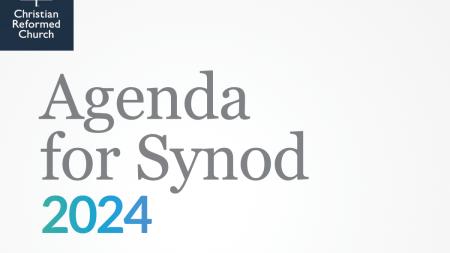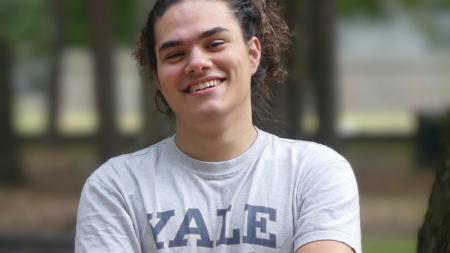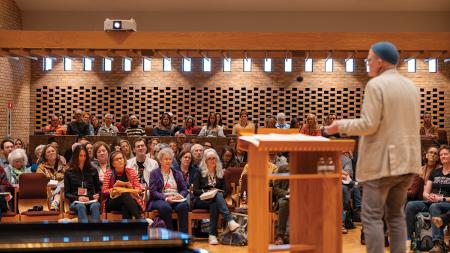Youth Group Learns New Lessons through Blanket Exercise

Chris Meehan
Near the end of a group activity known as the Blanket Exercise on a recent Sunday evening at Neland Avenue Christian Reformed Church in Grand Rapids, Mich., members of the church youth group watched a video in which Susie Silversmith told her story.
Silversmith is from the Navajo nation and was on hand at Neland Avenue CRC to help lead participants through a summary of Indigenous history as part of the Blanket Exercise. She had made a video as a way of sharing her stories with others.
In the video Silversmith spoke of the pain of having to attend the Kinlichee Boarding School near where she grew up in Arizona.
“I remember crying all of the time,” she said in the video. “My mother told me to never let them cut my hair, because then they would take away something important from me. I remember getting my first haircut, and it was terrible.”
She recalled that she had to give up the moccasins that her mother had made for her, that teachers hit her hands with the sharp end of a ruler for minor infractions, and that they washed her mouth out with soap when she spoke in her native language.
Before viewing the video, the young people at Neland had been stepping on blankets laid out on the floor to represent lands that Indigenous peoples had lived on before Europeans arrived in North America.
After the video and the exercise were finished, youth group member Hannah Ponstine said, “Watching the video and hearing Susie Silversmith's story was very impactful. It hits home so much harder when you meet a person that experienced something like this. I was so glad to have had this experience to learn more about the difficulties that Indigenous people have faced and are still dealing with the effects of today.”
Based on a workshop developed several years ago by the KAIROS ministry organization in Canada, the Blanket Exercise has been presented to more than 200 Christian Reformed congregations, Christian schools, and CRC groups since Synod 2016 recommended it be used as a way to tell the history of how native peoples in the United States and Canada were mistreated.
“Being part of it left me with a feeling of guilt and regret that our country, who said that ‘all men are created equal,’ could then turn around and steal the land of fellow people because their culture and their skin color were different,” said Ponstine.
Even as slavery was abolished, African Americans have gained more freedom, and women's rights have progressed, she said, while the injustices against Native Americans have been ignored.
“Participating in the Blanket Exercise made me much more aware of this,” she said, “and made me realize how much prejudice there was in our country's beginning, and how much is still there today.”
Neland brought the Blanket Exercise to the church to give youth group members a sense of Native American history before they take a mission trip next summer to Rehoboth Christian School, a CRC school on the Navajo reservation in New Mexico, which started as a boarding school in 1903.
As young people and others from the church stepped from one blanket to another, four people read from a script or acted out the exercise in different ways. The script sketched the narrative of Indigenous peoples’ lives before the arrival of Europeans and then how wars broke out between the groups, how treaties were made and broken, and how boarding schools were opened to “kill the Indian, and save the man.”
Assisting Susie Silversmith in leading the exercise were her husband, Richard; her sister, Darlene Silversmith; and Daniel Smiley. Susie and Richard Silversmith help to lead a Native American ministry in Denver, Colo. Smiley is a Mennonite pastor on the Navajo reservation.
Smiley opened the exercise by tapping on a small drum and chanting a prayer in Navajo.
Darlene Silversmith then began by asking everyone to take their places on the blankets, which, as the history unfolded, were removed one by one from under the participants’ feet to represent how native peoples lost their lands.
“This exercise is intended to help you deeply understand the relationship between the European people and native peoples. We will talk about the Doctrine of Discovery, which was a series of proclamations coming from people who claimed that Christians were more fully human than the ‘pagans’ living on the land they discovered,” said Darlene Silversmith.
“They believed the peoples had to be removed from their lands and converted. This exercise gives us the opportunity to learn about history from a perspective you may not be used to.”
Synod 2016 repudiated the Doctrine of Discovery, labeling it a heresy violating the laws of God.
The script described how diseases that Europeans brought with them, and from which they had immunity — such as smallpox — infected and killed thousands of Native Americans who had not been exposed such diseases. It also highlighted the Sand Creek Massacre that occurred in southeastern Colorado on Nov. 29, 1864. On that day a force of some 675 U.S. volunteer cavalry attacked a Cheyenne and Arapaho village and killed as many as 500 people, two-thirds of them women and children.
“The Banket Exercise was an amazing experience,” said Lille Dekker, a youth group member. “It was so difficult to hear about the terrible oppression of Indigenous peoples, and it's even worse to think about how it's not just stories but a reality to so many people even to this day.”
Shocked to realize she hasn’t learned of this history in school, Dekker found the exercise to be “truly eye-opening. . . . I went home reflecting on many things, but most important was this: ‘How can I say I'm getting a good and well-rounded education when I hadn't ever heard about these terrible acts and laws that oppressed entire people groups for hundreds of years?’”
Dekker also thought of what Susie Silversmith said about being forced to attend a boarding school.
“The Europeans who ran the boarding schools and forcibly converted people to Christianity did it in the name of the Lord. We look back on it and can see how misguided and tragic these acts were,” she said, “but I can't help wondering what we are doing today that we claim is done because we are Christians but is really only because we are greedy and hate-filled people.”
After the video, the presenters conducted a large “talking circle,” in which everyone had a chance to share their thoughts about the exercise. Susie Silversmith recounted how she was affected by the trauma of being separated from her family and having to attend a boarding school. She was filled with anger and hopelessness for many years. When she became a mother, she treated her own children poorly.
But a few of the things she had learned about God and the Bible at the boarding school began to take hold in her, she said: “They did teach me in good ways about God, who understood the complexities of my life.”
A turning point came, she said, she received a dream about a medicine man who came to visit in her hogan, the small home in which she was living far out on the reservation. “I welcomed him and discovered that the medicine man was Jesus,” she explained, “and how through his grace he restores me, and with his mercy he recreates me.”
Neland had invited the Office of Race Relations to put on the Blanket Exercise at a Sunday class for adults, and later asked if young people who would be going to Rehoboth could participate.
“For that reason, we invited our Navajo brothers and sisters so that the youth could learn from them before going to Rehoboth,” said Viviana Cornejo, a CRCNA race relations advocate. “They have been able to get an idea of 500 years of history in less than an hour.”


